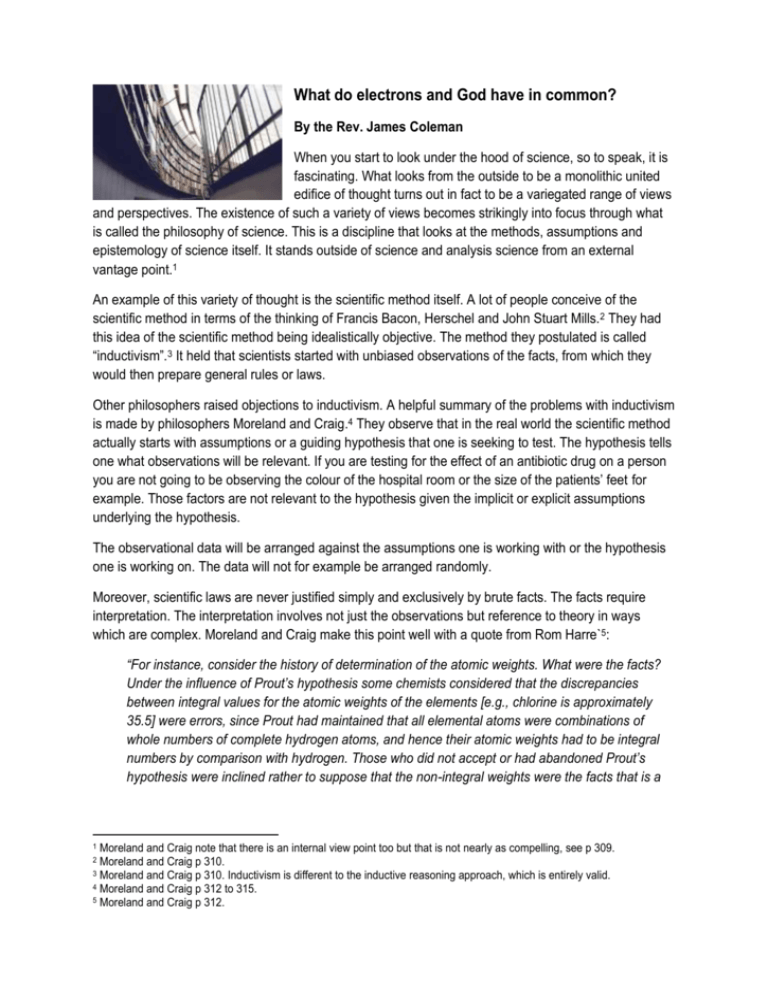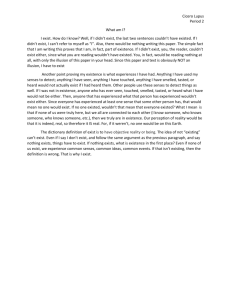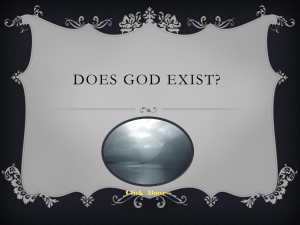Document 6826173
advertisement

What do electrons and God have in common? By the Rev. James Coleman When you start to look under the hood of science, so to speak, it is fascinating. What looks from the outside to be a monolithic united edifice of thought turns out in fact to be a variegated range of views and perspectives. The existence of such a variety of views becomes strikingly into focus through what is called the philosophy of science. This is a discipline that looks at the methods, assumptions and epistemology of science itself. It stands outside of science and analysis science from an external vantage point.1 An example of this variety of thought is the scientific method itself. A lot of people conceive of the scientific method in terms of the thinking of Francis Bacon, Herschel and John Stuart Mills.2 They had this idea of the scientific method being idealistically objective. The method they postulated is called “inductivism”.3 It held that scientists started with unbiased observations of the facts, from which they would then prepare general rules or laws. Other philosophers raised objections to inductivism. A helpful summary of the problems with inductivism is made by philosophers Moreland and Craig.4 They observe that in the real world the scientific method actually starts with assumptions or a guiding hypothesis that one is seeking to test. The hypothesis tells one what observations will be relevant. If you are testing for the effect of an antibiotic drug on a person you are not going to be observing the colour of the hospital room or the size of the patients’ feet for example. Those factors are not relevant to the hypothesis given the implicit or explicit assumptions underlying the hypothesis. The observational data will be arranged against the assumptions one is working with or the hypothesis one is working on. The data will not for example be arranged randomly. Moreover, scientific laws are never justified simply and exclusively by brute facts. The facts require interpretation. The interpretation involves not just the observations but reference to theory in ways which are complex. Moreland and Craig make this point well with a quote from Rom Harre`5: “For instance, consider the history of determination of the atomic weights. What were the facts? Under the influence of Prout’s hypothesis some chemists considered that the discrepancies between integral values for the atomic weights of the elements [e.g., chlorine is approximately 35.5] were errors, since Prout had maintained that all elemental atoms were combinations of whole numbers of complete hydrogen atoms, and hence their atomic weights had to be integral numbers by comparison with hydrogen. Those who did not accept or had abandoned Prout’s hypothesis were inclined rather to suppose that the non-integral weights were the facts that is a Moreland and Craig note that there is an internal view point too but that is not nearly as compelling, see p 309. Moreland and Craig p 310. 3 Moreland and Craig p 310. Inductivism is different to the inductive reasoning approach, which is entirely valid. 4 Moreland and Craig p 312 to 315. 5 Moreland and Craig p 312. 1 2 genuine measure of a natural phenomenon. What the facts were depended in part on whether on held or did not hold to a particular theory.”6 In fact from a finite set of observations there will be an infinite number of potential theories or laws that can be articulated that are consistent with the observed facts. Therefore it is logically wrong to conclude that a group of facts compels only one theory or law. Importantly what scientists are trying to do is not just describe the events that they observe but to provide a theories or justifications for the unseen mechanisms which really cause the observed data. 7 A second example of the variety of positions or view points within science relates to the philosophical models surrounding the explanatory power of science in terms of its laws or theories. Some scientists hold to the view that theories do not require belief in the entities postulated to exist by the theory.8 They see the theory only in terms its predictive output. That is in terms of its ability to accurately predict observable things.9 The completing theory and the one we are most familiar with from school is the realist, causal model of explanation.10 It postulates that the scientific explanation or theory gets in behind what can be observed and provides reasons for the phenomena observed. The model very often postulates the existence of things that we cannot be seen as being the real cause of the things that we can see.11 Thus the existence of electrons is postulated as existing and being responsible for say the flow of electricity in a metal and for other observable phenomena. Other examples of unseen postulated entities are gravitons, quarks and Hicks Bosons. The model asserts that the entities postulated by the theories really exist in a theory-independent world. It strikes me that from our schooling the realist, causal model is the model that the vast majority of the population uses and understands when it comes to scientific explanations. Under the model the population believes in the unseen entities postulated by the theory. A person who did not believe in electrons for example would be seen as not being rationally responsible. Interestingly, philosophers Bas C. van Fraasen and Stanley Jaki have shown that the realistic causal model of understanding scientific explanation is materially the same as the model used by say Thomas Aquinas in his proofs of God’s existence.12 Thomas Aquinas was a medieval theologian who offered proofs for the existence of God from reason alone not revelation.13 For example one of his proofs is called the cosmological argument for the existence of God. It starts with observational data, namely the fact that objects exist. A chair a plant a person a fish are all objects that exist. He then observed that these objects are all contingent. They are contingent in that they have not existed forever and were caused to exist by something external the thing itself. That external thing Rom Harre, The Philosophies of Science (Oxford: Oxford University Press, 1972), p 43. Moreland and Craig p 313. 8 Ibid p 319. 9 Ibid p 319. 10 Ibid p 319. 11 Ibid p 319. 12 Ibid p 319. 13 Alister E. McGrath, Christian Theology, and introduction (Blackwell publishing, 2007, p 160) 6 7 might be parents in the case of a person or a fish. It might be a tree in the case of a table. It might be the earth in the case of a mountain. He next observed that each thing in this chain is caused by something external to it. That all things only existed because something else external to it existed before the thing in question existed. That chain he reasoned could not stretch back with infinite past regression. It had to start somewhere otherwise nothing would have the necessary preconditions for existence. That first point in the chain. That first cause had to be a thing that existed in itself and did not need to be created. In other words that thing had to be God. Fraasen and Jaki’s point is that the reasoning of St Thomas Aquinas is materially the same as that of the realistic causal approach used in science.14 We all use the realistic causal approach with respect to say our acceptance of the existence of an electron. Just as we cannot see an electron, we cannot see God. But the logic demonstrating His existence is materially the same as that used to demonstrate the existence of an electron. Some object and might say that with an electron we can see a dial move on a volt meter and therefore electrons are real. The brute fact is however that one cannot see an electron. One infers their existence from theory seeking to explain observation. The theory is that the observed movement on a volt meter is caused by the electrons moving. The same situation occurs with faith. One can observe that the vast majority of humans believe in God, be they Jews, Christians or Muslims15. The “theory” behind this observable phenomena, is that God exists and his presence is causing the faith response in people. Perhaps this proves, that it is ultimately the state of a person’s heart that prevents them recognising and responding to God. 14 Moreland and Craig p 319. It is the character of God not the existence of God that is the distinguishing feature between the Abrahamic faiths. 15











